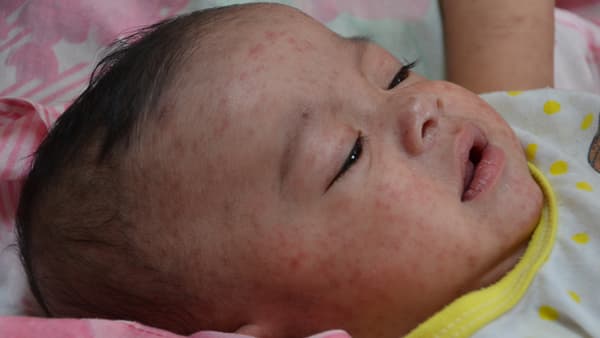Last year was marked by a resounding return: that of the measles epidemic. In Europe, as the World Health Organization (WHO) warned in a report shared on Tuesday, January 23, cases have skyrocketed compared to the previous year.
While 941 cases were recorded on the continent in 2022, 42,200 were recorded last year, a 45-fold increase in the 41 European countries affected. In France, for example, at least 64 cases of the disease have been identified in a school in Ardèche. But how to recognize measles and its symptoms?
A long incubation
As indicated on a WHO explanatory page, measles is transmitted “by droplets of secretions (nasal or pharyngeal) emitted by an infected person.” The time between contact with a sick person and the appearance of symptoms is quite long, with a delay of 10 to 12 days.
“During this phase, the virus is present in the respiratory tract, there it multiplies and spreads throughout the body through blood circulation,” explains a page dedicated to the disease written by Health Insurance.
Then, and even before recognizable red spots appear, the sick person should expect the following symptoms: rhinitis (runny nose), conjunctivitis and redness of the eyes, cough, severe fatigue and high fever “up to 39 -40°C” .
Three or four days after these first symptoms appear, it is the turn of reddish skin rashes. To identify them, look for “small, very red, slightly raised spots” on the skin.
Patches that first appear on the face, forehead, and cheeks before reaching the upper part of the body and continuing to the feet. A descent that is carried out gradually over approximately three days.

“Before the appearance of the typical measles rash, the treating doctor can sometimes highlight, in the mouth, whitish spots that look like grains of sand on the inside of the cheeks: this sign is typical of measles but is not always present “, Health also specifies. Sure.
Complications in 30% of cases.
In approximately one in three infections, complications are observed, especially in children under one year of age, before being vaccinated. But also in unvaccinated or immunosuppressed adolescents and adults.
“The most serious complications are more frequent in babies under one year of age and in adults over twenty years of age,” we can read on Ameli’s website.
Various types of complications may appear. Some are not serious (otitis, laryngitis, diarrhea), others may require hospitalization. These are cases of the appearance of keratoconjunctivitis, a serious eye condition. Or, in 1 in 1,000 cases, acute encephalitis, a serious neurological complication.
Need to relaunch the vaccination effort
In France, in recent years, mandatory vaccination and immunity resulting from previous measles epidemics have made it possible to significantly reduce the number of cases. However, the vaccination effort should not be relaxed, as requested by Catherine Russell, Director General of Unicef, on April 28, 2022:
“Measles is more than a dangerous and life-threatening disease. It is also one of the first signs that there are gaps in global vaccination coverage.”
According to his organization and the WHO, the Covid-19 pandemic has slowed the vaccination of children around the world, due to widespread disruptions in health services. In 2020, 23 million children worldwide did not receive basic childhood vaccines through routine health services.
“With the smallpox vaccine we have made smallpox disappear and we no longer vaccinate against smallpox. We can follow absolutely the same reasoning for measles,” says Dr. Philippe Reinert, member of the Vaccine Technical Committee, on the Ameli site.
Without forgetting that the vaccine has three advantages: it is “safe, effective and economical”, as supported by the WHO.
Source: BFM TV

